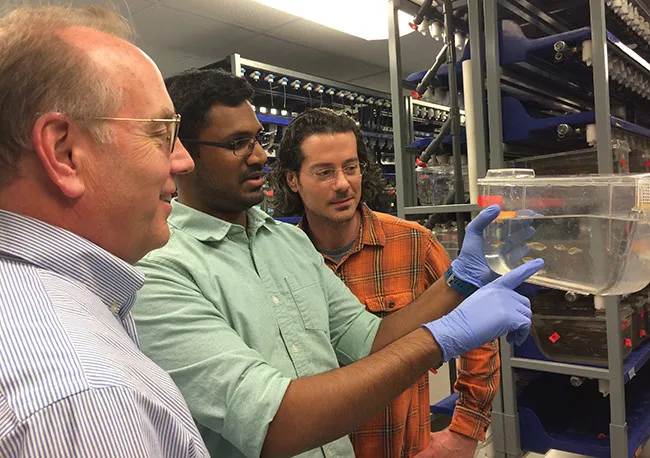Could the Tiny Zebrafish Teach Us to Cure Blindness?
By learning how zebrafish regenerate their retinas, researchers could figure out how to help humans do the same
/https://tf-cmsv2-smithsonianmag-media.s3.amazonaws.com/filer/82/8d/828d738a-5139-4649-89fb-0370df9f86b0/zebrafish.jpg)
Zebrafish are only a few centimeters long, but they’ve got some supersized powers. When their hearts or brains are damaged, they regenerate. When their fins are cut off, they grow back. When they are blinded, they can regain the ability to see.
It’s this last ability that’s the subject of some potentially groundbreaking new research. Vanderbilt scientists may have discovered the key to zebrafish retina regeneration. If the process can be replicated in humans, it stands to power new treatments for blindness caused by retinal disease and injury.
“As I learned more and more about how zebrafish are capable of regenerating most tissues and organs, I was intrigued, especially with the fact that the zebrafish retina can be damaged to cause blindness yet it only takes about three to four weeks before vision is restored,” says James Patton, the biological sciences professor at Vanderbilt who directed the research.
Zebrafish, a freshwater minnow named for their characteristic stripes, have long been a popular test subject for researchers. They breed easily in captivity, grow quickly, and as babies are completely transparent, which makes it easy to study their organs. Then there are their regenerative abilities. As they share 70 percent of humans' genetic code, it’s often possible to use them to study human genetic traits and diseases.
The structure and cell types of zebrafish retinas are almost identical to those of humans. Each contain three layers of nerve cells: light-detecting photoreceptors, signal-integrating horizontal cells, and ganglion cells that pass visual information on to the brain.
“So I became even more intrigued as to why humans cannot regenerate damaged retinas and fish can,” Patton says.

Retinal damage is behind many of the leading causes of blindness in the developed world. These causes include macular degeneration, an often age-related disease in which part of the retina becomes damaged, causing blurring and blank spots in vision; diabetic retinopathy, where diabetes damages the blood vessels in the retina; and retinitis pigmentosa, a genetic condition causing degeneration of the retina’s rod photoreceptor cells. Since human retinas do not regenerate, any retinal damage caused by disease or injury is permanent.
Patton and his team became curious about how, exactly, zebrafish retina regeneration is initiated. Previous studies have suggested that growth factors secreted by dying photoreceptors in the fishes’ eyes might start the process, sparking stem cells in the eyes to begin dedifferentiating (going back to an earlier developmental stage) and then differentiating into new retina cells. But Mahesh Rao, one of Patton’s graduate students, got the idea to look at the neurotransmitter GABA, a chemical messenger in the brain that reduces the activity of neurons, noting that GABA had been found to control stem cell activity in mice brains.
The team tested Rao’s idea by blinding zebrafish—this can be done by putting them in darkness for a few days, then exposing them to bright light—then giving them GABA-stimulating drugs. They also gave GABA-lowering drugs to normally sighted zebrafish. They found that the blind fish given GABA-stimulating drugs could not regenerate their retinas normally, while the normal fish with lowered GABA levels began regenerating their retinas. This suggested that it was, indeed, a lowered concentration of GABA that started the retina regeneration process.
The findings were published this month in the journal Stem Cell Reports.

“We hope to use the fish model to understand the factors and mechanisms regulating retina regeneration in the hope that we can apply lessons learned to humans,” Patton says.
The team is beginning to test the GABA theory on mice. If that works, it will be on to human trials, testing whether GABA inhibitors can stimulate retina regeneration.
If the research does indeed prove successful in humans, some of the nearly 40 million blind people worldwide may one day have a tiny, striped fish to thank.
/https://tf-cmsv2-smithsonianmag-media.s3.amazonaws.com/accounts/headshot/matchar.png)
/https://tf-cmsv2-smithsonianmag-media.s3.amazonaws.com/accounts/headshot/matchar.png)